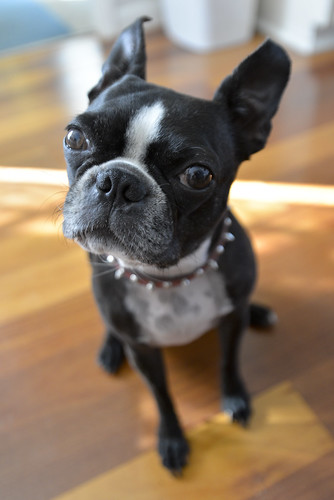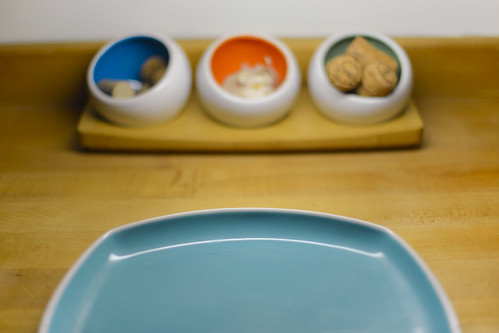I didn't want to jump into a quick review of the camera I've given myself a couple of weeks to handle the D600 take a few hundred pictures; portraits, pets, still life, and various other subjects, so I feel I'm finally familiar enough with the camera to have a good perspective of it. See the bottom of the page for some sample images.
Handling
As has been noted, the D600 isn't a far jump from the D7000. It's basically the same body with an FX sensor and a few buttons added and moved around here and there to keep up with the changes to the overall Nikon line. The D600 is by no means a small camera, but neither is it large. That being said, it fits in my hands well. The camera body is just large enough that my pinky finger doesn't hang off of the edge like it does with smaller bodies like the D5100 or the D3200. I think Nikon made it just about the right size for almost anyone to handle easily.The relatively compact size of the camera, while nice for some aspects does have a bit of a drawback. Being a FX camera of course it's made to be used with full frame lenses. The kit-lens, the Nikon 24-85mm f/3.5-4.5 is a great fit (as is the non-VR predecessor), but it's not really a lens for serious work. The problem comes up when trying to used Nikon pro lenses. The heavy f/2.8 zooms dwarf the camera. This isn't so much an aesthetic problem, but when shooting with these lenses the camera is a bit unwieldy especially without the battery grip. This also brings up the question as to how the polycarbonate front plate can handle the weight of a heavy telephoto like a 70-200 f/2.8 hanging from it for long periods of time.
That being said the D600 takes to the smaller fast Nikon primes really well. The 50mm f/1.4G is perfect and has been spending a lot of time on the camera. I've also been using more of my third party lenses with the D600 because they tend to be much smaller than their Nikon counterparts. The Sigma 17-35mm f/2.8-4 HSM has been getting a lot of time as well. It's a great low weight compact wide-angle and it's much more comfortable than the Nikon 16-35mm f/4 VR, it's also a stop faster at the wide end and about $800 cheaper! (it's not as sharp, but for $250 you can't beat it).
For handling I give the camera a good solid A. Although it's a bit clunky with the big lenses that's not really a camera problem. It's more of an issue with lenses. Maybe Nikon will introduce some fast, lightweight entry-level zooms in the future.
Controls
The controls on the D600 are laid out in the same fashion as the D7000 with a few features borrowed from the D800 like the Live View button and the Still/Video switch. Here's where it gets tricky to review. Mostly using the D300s/D700/D800 combo I've gotten used to the control layout having used it for about half of a decade while using other cameras such as the D60/D90/D3000/D5000/D7000 periodically. So while I'm familiar with the layouts with the other cameras, My muscle memory is tuned to the small body pro cameras.
Anyone stepping up from a D7000 will be instantly at home with the D600 and even D80/D90 users won't be completely lost. Nikon has always had an intuitive button layout even on the entry-level cameras. The D600 is no different. The buttons for the more important features such as ISO/QUAL/WB are located within quick reach on the back left panel, the release mode is easily accessible, and the metering and focus modes can be changed in an instant.
There are a few things about the D600 that I do not like at all. First and foremost, the location of the Fn button. Now this design has been around since the D80 and I still hate it. The Pv button lies perfectly under the middle finger during normal shooting, but to reach the Fn you must extend your pinky out to find it. The DXXX series have the Pv and Fn buttons set up so that they lie directly under the middle and ring finger. Super easy to find and press. Minor quibble yes, but it drives me nuts.
The other control I don't like is the record button behind the shutter release. Personally, I think all video and Live View controls should be on the back. Since you are looking into the monitor, it just makes sense to have all of the controls right there instead of having to press buttons all over the body. For Live View I have the AE-L/AF-L button programmed for AF-On, the record button should be right next to it, or even programmable to the OK button. Which brings me to my biggest complaint of all...
The OK button is not programmable for Playback mode. In most other Nikon cameras you can program the OK or center button of the multi-selector for different functions in during image review. One of these options is very important to me, View Histogram. During fast paced shooting or even during everyday shooting I like to hit play to review the shot, quickly press the OK button to check my exposure with the histogram. Long ago I quit trusting the LCD to assess exposure (as should everyone) and this is the fastest way to do this. On the D600 which is a relatively high end camera there is NO option to program the OK button in Playback. You get ONE option. Press the OK button and you pull up the Retouch menu, now the Retouch menu is all well and good, but it is far from an important feature that the OK button should be tied to it forever.
I understand that most of these are personal quibbles and a lot of folks may not have the same opinions about these controls as I do. As I said earlier, the D600 for the most part is a well though out camera in regards to button placement and can easily be mastered with a few hours of shooting.
Menus
The Nikon menu system has been pretty much refined for the last few years. Other than updates to the colors the menus remain pretty much the same as they've been since the D200. It's a very easy interface without a lot of sub-menus to get lost in. Nikon has this down.
Shooting
First and foremost, the D600's 24MP FX sensor is exceptional. The resolution is great. The image quality is impeccable and the noise levels are very low even at high ISO settings. I wasn't sure how well this sensor was going to perform, but it has definitely exceeded my expectations. I'm very pleased with the performance. Whether the it's the sensor or the new EXPEED 3 image processor or a combination of both this is probably the best performing sensor on the market. If they took the D600 sensor and put it into a D800 body I think Nikon would have an excellent small body pro camera.
The bad news is, the AF module which was based on the D7000 Multi-CAM 4800, simply has an FX tagged to the end of it. Nikon claims that the focusing system was tweaked for the FX sensor, but from all accounts and what I can see, it looks like Nikon just slapped the D7000 AF system in the D600 and called it good. Well, it's not that good. The 39 points are in exactly the same array as the D7000 which means that the AF points are crowded in the center of the frame, leaving the most of the frame free of focus points. This makes focusing on subjects according to the rule of thirds difficult without focusing and recomposing. On a static subject this is fine, but makes nailing focus on a moving subject tricky. When shooting portraits I found the same problem, to get focus on the eye you often have to do a loose composition because if your shooting wide open, focusing and recomposing gives your subject just enough time to move enough to throw off focus. Getting the exact composition right in camera is fairly difficult when shooting wide open, so prepare to compose loose to get sharp focus and use the megapixel advantage to crop later.
Another situation I've been having trouble with is locking focus quickly, especially in low-light, but in daylight as well. Even using a fast aperture f/1.4 lens I find the focusing sluggish and hesitant with quite a bit of hunting. I've tried every lens I own with the same results. Nikon claims that the Multi-CAM 4800 FX is supposed to be one stop more sensitive, but in my tests I'm not seeing any improvement. I'm going to my local camera shops to test out their D600 demo cameras just to be sure the fault isn't my camera alone. I've heard others report their Nikon D600's are focusing quickly, but there's no way of knowing what they are comparing it to. Using Live View however the focus is relatively quick, it still hunts a little, but it finds focus and locks pretty accurately.
Conclusions
All in all I think the Nikon D600 is a very good camera. It's groundbreaking in features being a full-frame camera in a non-pro body. It beats the pants off of Canon's 6D in features. Being the first camera of its kind I think the D600 has a little growing up to do. Basically a few added menu features and a major fix of the AF area array and this camera would be superb.
As far as image quality goes I don't think this camera can be beat. The noise is so incredibly low and the images have extraordinary detail especially when using good glass. It handles pretty well with small to medium sized glass on it and feels great in your hands, like all Nikons do. Adding a grip will balance out the large lenses a bit adding some stability.
It's not a perfect camera, but very few cameras are.





3 comments:
Thanks for the (p)review - I hope you are working on a manual for the D600!? Loved your D7000 one; moving back to FX and can't wait to get the camera and your tips & hints.
Thanks!
Terry
Thanks Terry. I am working on the D600 guide right now. We're making a few changes and I think this book will be more comprehensive than the D7000 guide.
amazing bokeh and beauty tone picture
thank you :)
Post a Comment